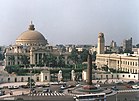Giza
الجيزة | |
|---|---|
Clockwise from top: Giza panorama, Pyramids of Giza, Cairo University, Great Sphinx of Giza, aerial view of Pyramids | |
| Coordinates: 29°59′13″N 31°12′42″E / 29.9870°N 31.2118°E | |
| Country | |
| Governorate | Giza |
| Founded | 642 AD |
| Government | |
| • Governor | Ahmed Rashed[1] |
| Area | |
• Total | 98.4 km2 (38.0 sq mi) |
| Elevation | 30 m (100 ft) |
| Population (2023)[2] | |
• Total | 4,458,135 |
| • Density | 45,000/km2 (120,000/sq mi) |
| • Demonym | Gizan (m) Gizanne (f) |
| Time zone | UTC+2 (EST) |
| Postal code | 5-Digit |
| Area code | (+20) 2 |
| Website | Giza.gov.eg |
Giza (/ˈɡiːzə/; sometimes spelled Gizah, Gizeh, Geeza, Jiza; Arabic: الجيزة, romanized: al-Jīzah, pronounced [ald͡ʒiːzah], Egyptian Arabic: الجيزة el-Gīza [elˈgiːzæ])[3] is the third-largest city in Egypt by area after Cairo and Alexandria; and fourth-largest city in Africa by population after Kinshasa, Lagos, and Cairo. It is the capital of Giza Governorate with a total population of 4,872,448 in the 2017 census.[4] It is located on the west bank of the Nile opposite central Cairo, and is a part of the Greater Cairo metropolis. Giza lies less than 30 km (18.64 mi) north of Memphis (Men-nefer, today the village of Mit Rahina), which was the capital city of the unified Egyptian state during the reign of pharaoh Narmer, roughly 3100 BC.
Giza is most famous as the location of the Giza Plateau, the site of some of the most impressive ancient monuments in the world, including a complex of ancient Egyptian royal mortuary and sacred structures, among which are the Great Sphinx, the Great Pyramid of Giza, and a number of other large pyramids and temples. Giza has always been a focal point in Egypt's history due to its location close to Memphis, the ancient pharaonic capital of the Old Kingdom.
- ^ "محافظ الجيزة يترأس اجتماع اللجنة التنفيذية للمبادرة الوطنية للمشروعات الخضراء الذكية", Masrawy, archived from the original on 2 September 2022, retrieved 2 September 2022
- ^ a b c "Egypt: Governorates, Major Cities & Towns - Population Statistics, Maps, Charts, Weather and Web Information". citypopulation.de. Archived from the original on 17 March 2023. Retrieved 17 March 2023.
- ^ Egyptian Arabic Place Names and Monument Names, 11 February 2019, retrieved 30 June 2023
- ^ Cite error: The named reference
:0was invoked but never defined (see the help page).








